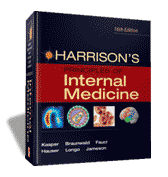Code Blue
 It's here! I finally got my copy of the newest edition of Harrison's Principles of Internal Medicine! Two whole volumes of full color photos and illustrations. I'm so inspired to start studying for my Medicine rotation (I start more than a month from today). A friend told me I must feel like how she feels whenever she buys herself new comic books. I guess I just have to take her word for it because I'll never know how it feels to have a new comic book just like she will never know how it feels to have a new medical textbook. Haha! That sounds so geeky. But my friend and I are both geeks (she's in grad school studying electrophysiology -- nothing more geeky than that) so that's okay.
It's here! I finally got my copy of the newest edition of Harrison's Principles of Internal Medicine! Two whole volumes of full color photos and illustrations. I'm so inspired to start studying for my Medicine rotation (I start more than a month from today). A friend told me I must feel like how she feels whenever she buys herself new comic books. I guess I just have to take her word for it because I'll never know how it feels to have a new comic book just like she will never know how it feels to have a new medical textbook. Haha! That sounds so geeky. But my friend and I are both geeks (she's in grad school studying electrophysiology -- nothing more geeky than that) so that's okay.Anyway, I wrote the following entry about 4 or 5 days ago, when I had my first 24-hour duty at San Lazaro Hospital. It was our first day back at UST today (ENT rotation now) and I never thought I'd appreciate how beautiful our hospital is compared to SLH. UST never smelled and looked so clean!
Blogger.com problems continue to beset me that's why the post is once again delayed. Anyway, read on...
*****
I'm currently rotating in San Lazaro Hospital (SLH), a government medical facility specializing in infectious diseases. They accept the most infectious cases that can't be handled by normal hospitals. During the SARS outbreak, they handled some of the cases reported in the Philippines. They were the referral center during the meningococcemia scare in Baguio. They have a whole pavilion for rabies, another for tuberculosis.
I found myself doing 24 hour duty at the TB Ward of SLH, popularly known in medical circles as Pav X (pavilion 10). This ward admits the most advanced TB cases that other hospitals just have to say no to. In fact, this is the only ward in the whole SLH that has its own ER/Triage area. Patients here sometimes have to share beds (and bacteria) because of the sheer number of inpatients. This ward is also popular for its mortality rate. There is not one single night that a cariopulmonary arrest (heartbeat and breathing stops) does not happen (at least that's what they all say -- it might be an exaggeration).
Anyway, so I was there, happily wearing my n95 mask (the mask popularized by SARS) inserting IV lines and interviewing patients at the triage. That night, we had 3 maydays (also known as a code or code blue; CP Arrest). It was part of our job, of course, to do CPR (cardiopulmonary resuscitation). A side note at this point is appropriate. As the TB cases seen at this ward are some of the most advanced, it's common knowledge that a mayday would surely mean the patient's death and that CPR is done mostly to satisfy the relatives that everything has been done to save the patient's life.
So anyway, we had 3 maydays. Two of them died. From the beginning, the pupils in both patients were already dilated (a very bad sign). At about 3am, we got the third mayday call from the nurse. We were already sleeping and so we had to put back our masks and shoes and had to rush to the patient's bedside. CPR was started as usual. But this time, after the second Epinephrine was given (in SLH, 3 doses are usually given before resuscitation is stopped), and I was pumping his heart and the nurse was ambubagging, the patient swallowed. And then he started to breathe spontaneously. Then his eyes moved. He was alive. I notified the resident that the patient was breathing spontaneously. The resident confirmed it - his heart was beating. We had saved the patient's life.
I never doubted that God had called me to this field. I knew it for sure at some point after I graduated from college. Sometimes though, I still question why I allow myself to undergo all the hard work and long nights at the hospital. It's at times like this one, being part of the team that saw the patient's heart beat again, that God strongly confirms my call to become a physician. It is here in medicine where I find fulfillment and it is here where my heart truly lies.

Comments